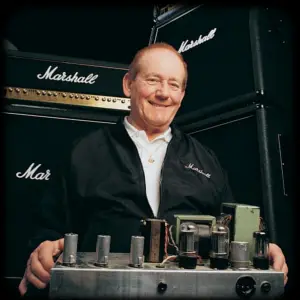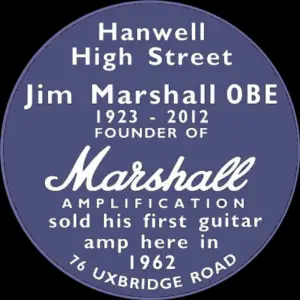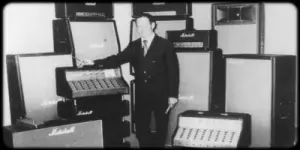JIM MARSHALL
 The ‘Marshall Stack’ is that tall black monolithic speaker set that you see behind most rock bands as they use its massive sound dynamic to tickle your ears one moment and blow your hair off the next. The man behind this vital equipment wanted to be a loud, wild, jazz drummer like his hero Gene Krupa, but he was destined to get on stage in a different way, and make his name famous to more people than any drummer in the world.
The ‘Marshall Stack’ is that tall black monolithic speaker set that you see behind most rock bands as they use its massive sound dynamic to tickle your ears one moment and blow your hair off the next. The man behind this vital equipment wanted to be a loud, wild, jazz drummer like his hero Gene Krupa, but he was destined to get on stage in a different way, and make his name famous to more people than any drummer in the world.
James Charles Marshall was born in Acton, London in 1923, and as a youth during WWII he worked as an electrical engineer during the day. In the evenings, he sang and played drums with a dance band, and he designed a PA so his voice could be heard above the musicians. It was small and light so it could fit in the little trailer Jim used to tow his drums to gigs behind his bicycle, as there was no petrol for private cars due to War rationing. Jim continued to sing and play during the 50s, and in 1960 he opened a drum shop in Hanwell.

English Heritage Blue Plaque to commemorate the location of the first Marshall Shop
Production in West London could not keep up with the huge demand for these brilliant, robust black boxes, with their unbelievably clear, loud sound. A factory was set up at Bletchley in Buckinghamshire, and this facility remains the headquarters of the company today, overseen by Jim’s son Terry. It was a match made in heaven when ‘Jimi’ (James Marshall) Hendrix went to Bletchley to order four double-sets of Marshalls (each had 16 speakers and 400w) to be shipped to strategic locations across the world. Despite the massive publicity value to the brand of having these stacks beaten up by Jimi on stage every night, he insisted on paying full retail price for them, on condition anything that broke would be instantly replaced. The kit was so bulletproof that Marshall never had to make good on that promise. Jimi’s use of feedback meant that his stack was just as much part of his instrumention as his Stratocaster was.
 As technology moved on, transistors were introduced into most other amps, but the ‘warm’ quality of valve amplification has always been a hallmark of that unique sound, along with something called the ‘Marshall Crunch’. Innovations have given today’s players more gain, cleaner split-channels, a range of tones and effects, and even more durable ‘Valvestate’ heads, but they all give that trademark Marshall sound. These products have become the industry standard and the sight of that iconic black monolith of the ‘Marshall stack’ has been seen on every major stage in the world. When Jim Marshall was awarded the honour of an OBE in 2003, it was for ‘services to the music industry’, but perhaps the Queen should have made him ‘The Lord of Loud’ instead. When Jim passed away in 2012, the site of his first shop was graced with a ‘Blue Plaque’ and his memory is honoured each year by the ‘Hanwell Hootenanny’.
As technology moved on, transistors were introduced into most other amps, but the ‘warm’ quality of valve amplification has always been a hallmark of that unique sound, along with something called the ‘Marshall Crunch’. Innovations have given today’s players more gain, cleaner split-channels, a range of tones and effects, and even more durable ‘Valvestate’ heads, but they all give that trademark Marshall sound. These products have become the industry standard and the sight of that iconic black monolith of the ‘Marshall stack’ has been seen on every major stage in the world. When Jim Marshall was awarded the honour of an OBE in 2003, it was for ‘services to the music industry’, but perhaps the Queen should have made him ‘The Lord of Loud’ instead. When Jim passed away in 2012, the site of his first shop was graced with a ‘Blue Plaque’ and his memory is honoured each year by the ‘Hanwell Hootenanny’.